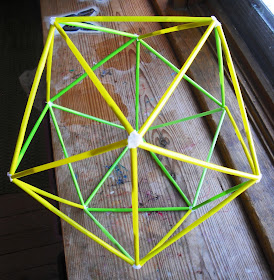Here's another view:
In a past post, I observed that illustrations of these solids are rarely to scale. I wondered how a icosahedron would compare to the unwieldy dodecahedron I made. Here's a family portrait of all the platonic solids, all constructed with six inch edges. See what you think:
Yup! Looks like a family, to me (Papa solid, Mama solid, sister solids, baby solid, lol)! But, clearly, the icosahedron, despite more faces and the same number of edges, is smaller than the dodecahedron. For what it's worth, I guess I have my answer about the scale issue.
Hmmm...I wonder what I should try next? And, here's a question: if the kid's not involved in the making, would my obsession be considered parental neglect, do you think, or could I just call it 'enriching her learning environment'? I'm thinking about one of these (source), something truncated or stellated...




Real mathematicians ask new questions.
ReplyDeleteI love your question about scale. And I'm perplexed about why the same number of edges gives such different sizes. I want to explore this now.
Thanks for sharing your explorations.
Sue, I'll be really interested in what you figure out!
DeleteMalke, have you done the movement scales of the icosohedron, a la Rudolf von Laban? It's such a great way to experience the icosohedron -- from the inside of an imaginary one!
ReplyDeleteMeg, I've heard that Laban created his notation in relation to the icosohedron, but I didn't know about the movement scales until now! I'll go look it up. Thanks!
ReplyDeletereally cool idea i love it! thanks
ReplyDeletefor publishing this.
Malke, do you knit?
ReplyDeleteCheck out this free pattern from Norah Gaughan, who is often inspired by mathematics. http://www.ravelry.com/patterns/library/celestine
I so admire the construction method she used - it makes the arms modular, so the complex project has short instructions - every designer's goal. Clear, not too much ink or paper used up.
I do knit...a little. I'm not sure I have time for this right now, but it looks amazing! Thanks for the link! :-)
ReplyDelete